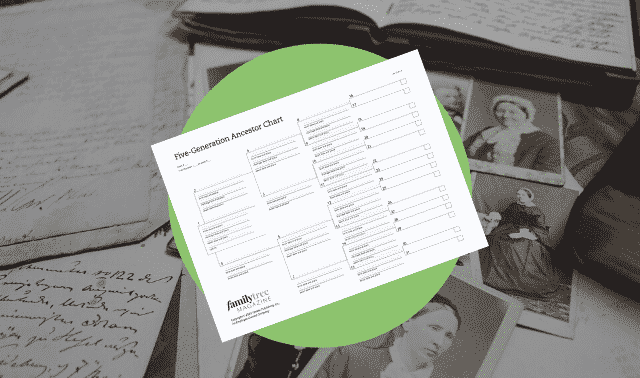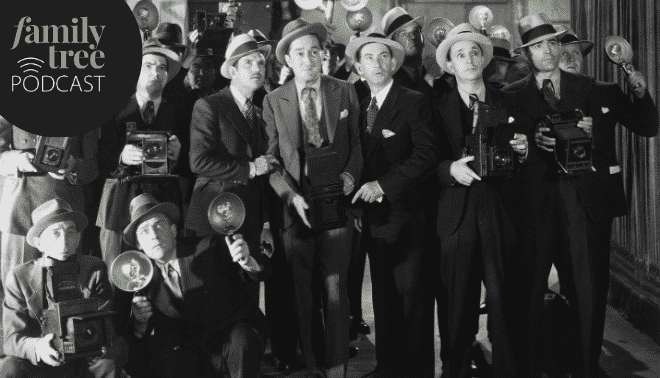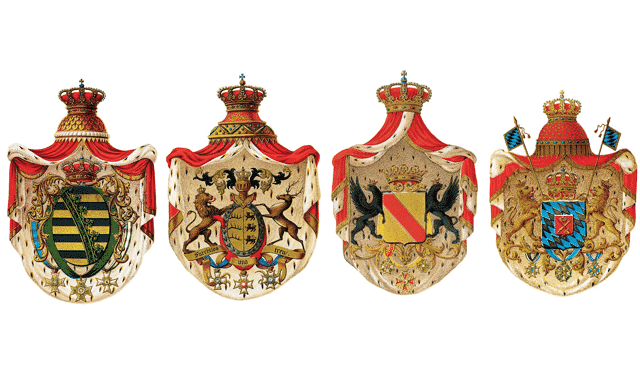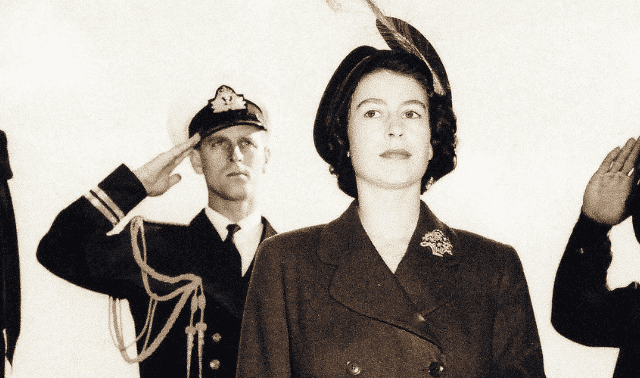You never know when you might stumble across a royal ancestor.
Gilbert von Studnitz of Benicia, California, was rummaging through some old boxes in his grandmother’s attic when he first realized he had ties to royalty. In those attic boxes, he found family photos from the 1850s that prompted him to question his grandmother, who told him he descended from Landgrave Wilhelm IV of Hesse. Von Studnitz soon learned that his ancestors included many Holy Roman emperors (Charlemagne among them) and hundreds of European kings. “Through this descent, I am distantly related (8th-12th cousin) to almost every reigning European monarch today,” he says.
Whether you accidentally come across a royal connection as von Studnitz did, or purposely seek one out in your research, the discovery of regal ancestry can be a real thrill. Suddenly, your ordinary family is transformed into descendants of the world’s most powerful rulers. History takes on a new dimension when you can say, “King Henry VIII was my distant cousin!”
Royal Roots Research
Surprisingly, royal roots aren’t as rare as you might think. More than 60 percent of Americans are descended from royalty, according to Gary Boyd Roberts, author of The Royal Descents of 500 Immigrants. But suspecting you have royal roots and proving it through genealogical research are two different things. If you want to honestly boast of your blue blood, coming up with the proof may not be easy.
You’ll probably have to trace back through many generations to get to your royal connection, and the farther back you go, the tougher it is to find documentation. If your connection is through a female line or illegitimate heirs, you may find fewer records to back up your claims. Also, forged or inaccurate published genealogies may add to your trouble—if you follow their false leads and information unknowingly.
But genealogists thrive on challenges, right? Royal roots research is full of them, but even if you never discover or prove your kinship to kings and queens, you’ll learn more about your commoner ancestors and the times in which they lived. Follow these steps to the crown (or lack of one) in your family tree.
1. Start with what you already know.
“[Royal research] is really no different an approach than one would normally take when researching one’s ancestry,” says professional genealogist Timothy Boettger, who specializes in European nobility. “You start with what you know and work back systematically, generation by generation, documenting carefully as you go. If there is a link, it will be found in due course.”
You may be tempted to work from a suspected royal ancestor forward to make the connection to your family, but that’s not the best way to go, experts say. Neil Thompson, a professional genealogist in Salt Lake City, warns, “So many times I have had to tell clients that the line breaks before the emigrant ancestor is reached, so that even if the connection to royalty is established for the emigrant, the client is not helped.”
The good news here is that genealogical record-keeping and royalty are inextricably intertwined. You might even say that genealogy began with royalty, for whom a family tree was not just a hobby—it was the foundation of their claim to the throne. So once you do work backwards to royal kin, you’ll be able to follow that line back many more generations. That’s how von Studnitz could connect with Charlemagne, way back in the eighth and ninth centuries.
While you shouldn’t believe everything you hear, don’t completely dismiss those family stories you’ve heard about royal connections. They may contain a few grains of truth, which can help start your search in the right direction. That’s what von Studnitz did, with astounding results. Not only did he prove his royal roots, he discovered that his great-grandmother’s uncle was the scientist who discovered the “Neanderthal Man” in 1856, and that his third-great-grandmother’s brother was the doctor who founded homeopathy. “It boils down to using family stories as a starting point only,” he says, “and making sure you can document as many details as possible to verify what is the truth.”
2. Look for telltale clues.
Use your ancestors’ geographic and class origins as clues. According to author Roberts, most Americans with royal roots have New England Yankee, Pennsylvania Quaker or Tidewater planter forebears. The immigrants who brought their blue blood with them to the New World were most likely Puritans settling in New England, Quakers (often Welsh) in Pennsylvania, Scots in mid-Atlantic states (some to Virginia) and Anglican “cavaliers” to Tidewater Maryland, Virginia and South Carolina. If you have a sizable number (50 to 100) of immigrant ancestors in one or more of these areas, you “can expect to find a royally descended forebear,” Roberts says.
Other good indicators are gentry-level occupations such as a wealthy farmer or merchant, governor, minister or military officer. Find out as much as possible about the emigrant, his wife, children, occupation, religious beliefs and anything else that might help to place him in a proper family, Thompson advises.
Once you’ve spotlighted a potential connection, you can begin checking to see if he or she has royal forebears.
3. Research your possible connection to royalty.
What do you know about this ancestor (or ancestors) you suspect has royal family ties? Determine what sources (books, films, microfiche, indexes, etc.) are available at libraries for that surname, recommends Hilary Jefferies, a professional genealogist in Aurora, Colorado. She says to look for sources such as:
- The Complete Peerage, Scot’s Peerage and other peerage books
- Family histories and surname books: More recent histories are best because new facts and documentation have been added.
- County or place histories: These are geographically oriented and deal with a parish, manor house or county, and with the prominent local families.
- Documented visitations: Records of church-related parish matters (fees, attendance and deaths)
- Periodicals containing local history and genealogy
- Related surname family histories
- Royal genealogies
- Gentry sources, such as Burke’s Landed Gentry or Burke’s Commoners. These may not be as accurate as other sources, but they will usually deal with the extended family in addition to the eldest male line.
- Heraldry books: These books contain genealogies and coats of arms granted to individuals in a family.
For more specific sources, consult a genealogy reference librarian or other knowledgeable professionals. Check all sources for the common surname spelling plus variant or alternative spellings, and photocopy the pages where that surname is found. Then make a list of sources for that family by locality and title. Be careful not to assume that because someone has the same name as your ancestor, he must be your ancestor. Find corroborating evidence such as a birthdate or spouse’s name before coming to a conclusion.
4. Beware of scams and incorrect/conflicting data.
We all know the internet is a terrific resource for genealogists, but it also spreads false family history information just as easily as it spreads celebrity gossip. Whenever you find a site containing royal and noble genealogies, consider their “facts” as clues only and verify them yourself. See what kind of documentation these sites offer; the more records and authentic sources they cite, the more reliable the data probably is. “Learn to do good solid research,” advises Valerie Austin, a royal researcher in Gainesville, Florida. “Be skeptical of long lines others send, unless you go about the work of verifying them yourself.”
Print sources are no different. These may contain inaccurate, conflicting or even purposely falsified genealogical information. “Many royal and noble ancestries have been produced over the centuries that are often more the results of wishful thinking than scientific research and documentary evidence,” says genealogist Boettger. “It seems to be a phenomenon common to every age and civilization.” In the 15th and 16th centuries, for example, families of social standing were expected to have ancestries dating back to ancient or Biblical figures, or even legendary heroes, so many families hired genealogists to “find” (or invent) such connections. “Thus numerous fanciful family origins were created,” Boettger says. Adding to the problem, 19th-century genealogical scam artists such as Gustave Anjou and Horatio Gates Somerby “made a living concocting false ancestries, often with alleged royal roots, for unsuspecting clients,” says genealogist Thompson.
Kriste Wood, a royal researcher in Oklahoma, found that proving her roots could get confusing when books and experts didn’t agree on what was accurate. “I found that the ‘experts’ disagreed heatedly on what I thought was common knowledge in history books, Jewish lineages and royal lineages,” she says. “Many ‘authoritative’ books were quoted, but were maligned in turn. I don’t believe many [experts] agree on most lines.” The bottom line is, be careful about your sources, and always try to reference original documents if possible.
5. Learn the lingo.
If you want to be a royal researcher who’s in the know, master a few key terms that will come up often. First, “royalty” only applies to the rulers (kings, queens, princes, princesses) and their immediate families. “Nobles” are the families of high and hereditary rank, often descendants of kings’ younger sons, but not always related by blood to royalty. “There is a distinction to be made between nobility and royalty,” Boettger says.
“Although the former may, in the case of very old noble families, have been at one time royal themselves or descend from a cadet branch of a royal family, most of the noble families of a country do not themselves belong to the ruling family of that country. Furthermore, being noble did not necessarily mean that one bore a title (duke, earl, baron, etc.), and in some countries, on the contrary, one could bear a title without being noble.” In Russia, for instance, men could acquire hereditary nobility when they became colonels in the army, says Boettger. So if you have Russian nobility in your family tree, it doesn’t automatically mean they were “titled” or related to the czar. Finally, the “gentry” are the remaining families of rank, whose titles vary from country to country.
Once you begin digging into royal genealogies, you may encounter certain Latin or French abbreviations:
- sp or S.p.: sine prole (Latin) or sans posterite (French); without issue
- d.S.p.: decessit sine prole (Latin) or décedé/décedée sans postérité (French); died without issue
- O.S.p.: obiit sine prole (Latin); died without issue
- V.p.: vita patris (Latin); during the life of the father
- d.V.p.: died before his (or her) father
- O.V.p.: obiit vita patris; died before his (or her) father
- V.m.: vita matris (Latin); during the life of the mother (usually implies that the mother was an heiress of some sort)
- O.V.m.: obiit vita matris (Latin); died before his (or her) mother
- S.p.l.: sans postérité légitime (French); without legitimate issue (Note that s.p. usually implies “without any issue either legitimate or illegitimate,” whereas s.p.l. usually implies “without legitimate issue but with illegitimate issue.”)
- S.p.m.: sine prole masculina (Latin); without any sons (usually implies “with daughters”)
For a more in-depth list of noble, princely, royal and imperial titles, check out the website page A Glossary of European Noble, Princely, Royal and Imperial Titles.
6. Join forces with royal roots researchers everywhere.
You’re not alone in your quest for the crown in your family tree. Millions of others across the world are seeking the same thrill—and facing the same challenges. Enlist their help, and you may just discover the key to your ancestors, or break through the brick wall standing in your path.
Now that you’re aware of the pitfalls and pleasures of royal genealogy, nothing stands between you and the discovery of your family’s majesty. Along the way, you’ll no doubt find that many of your “commoner” kin were pretty uncommon, too—and that might just be the crowning touch in your quest for royal roots.
Royal genealogy research resources
Websites
General
Almanach de Bruxelles: search for present and former sovereign families of non-European countries and regions
Cyndi’s List: Royalty & Nobility: links to royal and noble genealogy websites
Hoelseth’s Royal Corner: links to hundreds of royal websites all over the world
Russia
Nobility of the World, Volume VIII – Russia: background information and genealogies of titled Russian families; includes a biographical and pictorial archive
United Kingdom
Burke’s Peerage: subscription database of 650 leading Scottish families, biographies of hundreds of influential figures plus Burke’s Peerage & Baronetage
Royal Family Tree: family tree of British monarchs through the ages
Books
Burke’s Peerage, Baronetage and Knightage (two volumes) edited by Charles Mosley
Colonial Americans of Royal and Noble Descent Alleged, Proven and Disproven by Patricia Ann Scherzinger
The Complete Peerage of England, Scotland, Ireland, Great Britain and the United Kingdom (multiple volumes) by George Edward Cokayne
Kings and Queens of Europe: A Genealogical Chart of the Royal Houses of Great Britain and Europe by Anne Taute
Plantagenet Ancestry of 17th-Century Colonists by David Faris
Royalty for Commoners by Roderick W. Stuart
Can peerage books be trusted as reliable resources?
Q: Are Debrett’s Illustrated Baronetage and Burke’s Peerage & Baronetage considered reliable references? How about ones that are no longer printed, such as Burke’s Extinct & Dormant Baronetcies (1811, 1985) or Lodge’s Peerage, Baronetage and Knightage el Companionage of the British Empire for 1911? And if these are not reliable, is there a way of getting access to records that are verifiable?
A: To be able to tie your family line in to the titled families of Great Britain is a genealogist’s dream. Let’s first address who will be in these types of books, and then how to use these volumes.
Noble titles descend in rank in the following order: royalty (king, queen, prince, princess), archbishops, peers (duke, marquis, earl, viscount, bishop-lords spiritual, baron) and gentry (baronet, knight, esquire, gentleman). The most reliable source for titled families is The Complete Peerage of England, Scotland, Ireland, Great Britain and the United Kingdom: Extant, Extinct or Dormant by George E. Cokayne, published in 13 volumes between 1910 and 1959. An addition, The Complete Peerage: Volume XIV Addenda and Corrigenda edited by Peter W. Hammond, was published in 1998. But this volume isn’t in many collections. This series focuses on the titleholder, not the family. A transfer in title is common if the holder died without children.
Depending upon the time period you’re researching, focus on the probate records: They generally reconstruct the living family. You can go from there into church records and civil registration to confirm birth and christening, marriage, death or burial dates. It’s important to document each link in the family tree thoroughly. Do not assume that because you have proven one link that it all must be correct.
The content of the books for titled families will vary as the family changed throughout time, so check multiple editions. The majority of these books contain errors such as missing generations, women married to the wrong men, children omitted and incorrect dates. A family line didn’t have to be proven before inclusion. So use these books as a road map for your research—if the information is correct, it will be easy to document.
Q&A answer provided by Paul Milner in the February 2003 issue of Family Tree Magazine.
Related Reads
A version of this article appeared in the April 2002 issue of Family Tree Magazine. Last updated: June 2025
FamilyTreeMagazine.com is a participant in the Amazon Services LLC Associates Program, an affiliate advertising program designed to provide a means for site to earn advertising fees by advertising and linking to affiliated websites.










